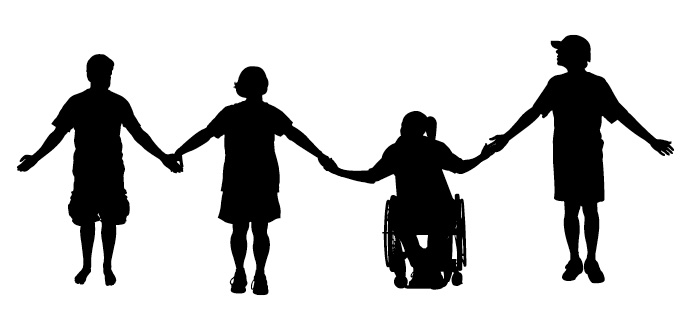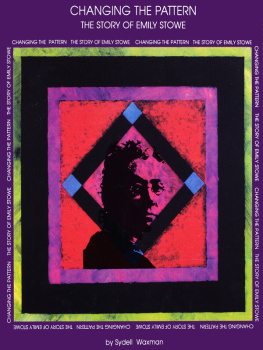Emily Included
A True Story
Kathleen McDonnell

LIBRARY AND ARCHIVES CANADA CATALOGUING IN PUBLICATION
McDonnell, Kathleen, 1947
Emily included / by KathleenMcDonnell.
PRINT ISBN 978-1-926920-33-7/E-ISBN 978-1-926920-42-9
1. Eaton, EmilyJuvenile literature.2. Children with
disabilitiesCanadaJuvenile literature. 3. Childrenwith
disabilitiesEducationCanadaJuvenile literature. 4.Inclusive
educationCanada--Juvenile literature. 5. Mainstreamingin
educationCanadaJuvenile literature. I. Title.
HV890.C3M352011 j362.40830971 C2011-904504-4
Copyright 2011 by Kathleen McDonnell
Edited byGena Gorrell
Designed by Melissa Kaita
Lyrics to Three Rows Overused with the kind permission of Bobby Curtola
All photos courtesy the Eaton family
Photo on page 44 the TorontoStar
Cover article the Toronto Star
Second Story Press gratefully acknowledgesthe support of the Ontario Arts Council and the Canada Council for the Artsfor our publishing program. We acknowledge the financial support of theGovernment of Canada through the Canada Book Fund.

Published by
Second Story Press
20 Maud Street, Suite401
Toronto, ON M5V 2M5
www.secondstorypress.ca

PROLOGUE
May 1993
Emily waited by the front door in her wheelchair, whileher mother called her brothers from the bottom of the stairs.
Boys? Whats going on up there?
Be right down, said Peter, Emilys oldest brother. Im just doingup Bryans tie.
We need to get going. We cant be late!
The Eaton house was usually in a flurry of activity in the morning, aseveryone got ready for work or school. But today was a very important day,and things were more hectic than usual. The two boys came bounding down thestairs, and Emily laughed when she saw Bryan, her youngest brother. He wasten, and she could tell by the look on his face that he wasnt one bit happyabout wearing a suit and tie.
But this was not a day for jeans and sneakers. They all had to looktheir best. Emily was wearing her good plaid skirt and a white blouse with tinybuttons. For once, she was the first one ready. Well, almost ready except forthe cornflower blue headband her mom had bought specially for today.
Emilys father came in from outside, where he had been waiting withMark, the middle brother. Looks like everybodys good to go, he said. Letsget in the car. He gestured to Mark, who sprinted into the house to pushEmilys wheelchair.
Wait aminute! Emily wanted to shout, as Mark wheeled her out the frontdoor. Im not good togo!
Didnt anyone notice that she didnt have her headband on? Couldntthey see? So much fuss about the boys and their neckties, but today was allabout Emily. Everybody would be looking at her and she wanted them to see herin her new blue headband.
It was so frustrating not to be able to talk!
As her dad lifted her from the wheelchair into the back seat of thecar, Emily let out a loud screech. He was so startled that he almost lost hisbalance, but he held on tight to Emily. She could tell he was about to launchinto one of his lectures about not using her loud voice. But before he could sayanything, Emilys mother spoke up.
Hold on, Clayton. I think I know what shes upset about.
She hurried into the house and came back carrying something. Atfirst all Emily saw was a blur, but as her mother came closer Emily recognizedthe curved object dotted with tiny roses of cornflower blue silk.
Sorry, sweetie, her mom said as she stretched the headband overEmilys hair. We almost forgot it.
Emily let out a sigh of relief. Now she felt ready to go to thehearing and meet the people who might turn her whole life upside down. They werecalled the Special Education Tribunal, and they were going to decide whetherEmily could stay in her grade two class at Maple Avenue School, or whether shewould have to leave her friends and go to some strange new school.
CHAPTER 1
A Regular School
Maple Avenue School was such a big part of Emilys lifethat she couldnt imagine what it would be like without it. She still rememberedthe very first time her parents had taken her there, to meet the principal, whenshe was five years old.
Back then, she wasnt even sure she wanted to go to a regularschool. Ever since she was a baby, Emily had gone to the Granville ChildrensCentre, where all the kids had disabilities. They went to Granville forphysiotherapy, speech therapy, playtime, and special celebrations likeHalloween. She was used to going to Granville. But Maple Avenue was the kind ofschool her brothers went to. What would it be like? What did kids do there?
On that first visit, as her father pushed her wheelchair down thelong hallway, they passed rooms filled with kids. Some were quietly reading orwriting at desks. Others were talking and working together at tables. There wereshelves of games and sports equipment, and the walls were covered with colorfulartwork. In one room, Emily saw children standing around a piano, singing loudlyas a teacher played for them. The sound of their voices sent ripples ofexcitement through her body. She wanted to be one of those kids. She wanted tostand at the piano and sing at the top of her lungs.
This place was really different from Granville!
When they arrived at the office, the principal greeted them andasked Emilys parents about her condition. They told him that Emily had cerebralpalsy, because her brain had not had enough oxygen during her birth, and she hadhad seizures in the first few days of her life.
Cerebral palsy isnt just one condition, explained Emilys mother,Carol. It causes different problems in different people. In Emilys case, herbody is floppy so she doesnt have much control over her movements. And shecant see very well, because her eyes dont focus together.
Emilys father, Clayton, spoke up. When she was a baby, her doctorssaid she would never be able to sit up or walk or feed herself. One doctor eventried to tell us she would be like a vegetable! But we refused to believe allthat. We were determined not to limit her possibilities.
It was difficult when Emily was born, Carol added. Peter was onlyfive, Mark was three, and Bryan was just nineteen months old still a babyhimself. It was a struggle to explain her condition in words they couldunderstand. But as they got older, the boys learned to treat her like any otherkid. They play with her, they read her stories, they sing to her.


Peter was only five when Emily was born. Mark was three,and Bryan wasnt even two. It was hard for them to understand hercondition at first. Before long, though, the boys treated her just likeany other kid.
Emily listened as her parents explained the progress she had made.Despite the doctors predictions, by the time she was eighteen months old shecould sit up. By the age of three she could eat with a spoon, and hold her owndrinking glass. Using a walker and special leg braces that helped her stand up,she could even walk short distances. But she still needed a lot of assistance todo things that were easy for most kids her age.
















